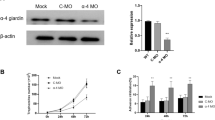Abstract
In a previous study, we reported that the novel annexin XX1 (annexin E1), identical to α14-giardin, is specifically localized to the flagella and to the median body of the trophozoites. However, the mode of interaction and the direct partners involved remained unclear. In the present study, we show that α4-giardin obviously does not evenly distribute over the full length of the axonemes, but rather, resides at local slubs near the proximal part and the ends of the flagella. In immunocytochemical co-localization studies, the anti-giardin primary antibody exclusively reacted with distinct regions of the flagella in permeabilized cells, whereas the anti-tubulin antibody bound to all areas of the axonemes in the cells and to isolated cytoskeletons. Isolated cytoskeletons did not react with anti-giardin antibodies. α14-Giardin itself is able to assemble to multimeric structures. Taken together, our findings suggest that α14-giardin adheres to microtubules of the flagella via self-assembly that may regulated by Ser/Thr-phosphorylation.





Similar content being viewed by others
References
Adam RD (2001) Biology of Giardia lamblia. Clin Microbiol Rev 14:447–475
Allore RJ, Barber BH (1984) A recommendation for visualizing disulfide bonding by one-dimensional sodium dodecyl sulfate-polyacrylamide gel electrophoresis. Anal Biochem 137:523–527
Bauer B, Engelbrecht S, Bakker-Grunwald T, Scholze H (1999) Functional identification of alpha 1-giardin as an annexin of Giardia lamblia. FEMS Microbiol Lett 173:147–153
Blom N, Sicheritz-Ponten T, Gupta R, Gammeltoft S, Brunak S (2004) Prediction of post-translational glycosylation and phosphorylation of proteins from the amino acid sequence. Proteomics 4:1633–1649
Clark JT, Holberton DV (1988) Triton-labile antigens in flagella isolated from Giardia lamblia. Parasitol Res 74:415–423
Crossley R, Holberton DV (1983) Characterization of proteins from the cytoskeleton of Giardia lamblia. J Cell Sci 59:81–103
Douglas M, Finkelstein D, Butow RA (1979) Analysis of products of mitochondrial protein synthesis in yeast: genetic and biochemical aspects. Methods Enzymol 56:58–66
Drewes G, Ebneth A, Mandelkow E (1998) MAPs, MARKs and microtubule dynamics. Trends Biochem Sci 23:307–311
Edwards HC, Crumpton MJ (1991) Ca2+-dependent phospholipid and arachidonic acid binding by the placental annexins VI and IV. Eur J Biochem 98:121–129
Elmendorf HG, Dawson SC, McCaffery JM (2003) The cytoskeleton of Giardia lamblia. Int J Parasitol 33:3–28
Embley TM, Hirt RP (1998) Early branching eukaryotes. Curr Opin Genet Dev 8:624–629
Gillin FD, Reiner DS, McCaffery JM (1996) Cell biology of the primitive eukaryote Giardia lamblia. Annu Rev Microbiol 50:679–705
Keister DB (1983) Axenic culture of Giardia lamblia in TYI-S-33 medium supplemented with bile. Trans R Soc Trop Med Hyg 77:487–488
Matsudaira P (1987) Sequence from picomole quantities of proteins electroblotted onto polyvinylidene difluoride membranes. J Biol Chem 262:10035–10038
McArthur AG, Morrison HG, Nixon JE, Passamaneck NQ, Kim U, Hinkle G, Crocker MK, Holder ME, Farr R, Reich CI, Olsen GE, Aley SB, Adam RD, Gillin FD, Sogin ML (2000) The Giardia genome project database. FEMS Microbiol Lett 189:271–273
Morgan RO, Fernandez M-P (1995) Molecular phylogeny of annexins and identification of a primitive homologue in Giardia lamblia. J Mol Evol 12:967–979
Neuhoff V, Arold N, Taube D, Ehrhardt W (1988) Improved staining of proteins in polyacrylamide gels including isoelectric focusing gels with clear background at nanogram sensitivity using Coomassie Brilliant Blue G-250 and R-250. Electrophoresis 88:255–262
Peattie DA (1990) The giardins of Giardia lamblia. Parasitol Today 6:52–56
Peattie DA, Alonso RA, Hein A, Caulfield JP (1989) Ultrastructural localization of giardins to the edges of disk microribbons of Giardia lamblia and the nucleotide and deduced protein sequence of alpha giardin. J Cell Biol 109:2323–2335
Rescher U, Gerke V (2004) Annexins—unique membrane binding proteins with diverse functions. J Cell Sci 117:2631–2639
Roger AJ (1999) Reconstructing early events in eukaryotic evolution. Amer Nat 154:146–163
Roth J, Bendayan M, Carlemalm E, Villiger W, Garavito M (1981) Enhancement of structural preservation and immunocytochemical staining in low temperature embedded pancreatic tissue. J Histochem Cytochem 29:663–671
Sogin ML, Gunderson JH, Elwood HJ, Alonso RA, Peattie DA (1989) Phylogenetic meaning of the kingdom concept: an unusual ribosomal RNA from Giardia lamblia. Science 243:75–77
Szkodowska A, Muller MC, Linke C, Scholze H (2002) Annexin XXI (ANX21) of Giardia lamblia has sequence motifs uniquely shared by giardial annexins and is specifically localized in the flagella. J Biol Chem 277:25703–25706
Weiland ME, McArthur AG, Morrison HG, Sogin ML, Svärd SG (2005) Annexin-like alpha giardins: a new cytoskeletal gene family in Giardia lamblia. Int J Parasitol 35:617–626
Acknowledgement
The authors thank Dr. Jan Hegemann (European Neuroscience Institute, Göttingen) for valuable advice in electron microscopy and Dr. Stefan Walter for performing ESI-MS. This work includes parts of the doctoral thesis of A.V., who is a recipient of a grant from the research training group 612 of the Deutsche Forschungsgemeinschaft.
Author information
Authors and Affiliations
Corresponding author
Additional information
An erratum to this article can be found at http://dx.doi.org/10.1007/s00436-007-0814-2
Rights and permissions
About this article
Cite this article
Vahrmann, A., Šarić, M., Scholze, H. et al. α14-Giardin (annexin E1) is associated with tubulin in trophozoites of Giardia lamblia and forms local slubs in the flagella. Parasitol Res 102, 321–326 (2008). https://doi.org/10.1007/s00436-007-0758-6
Received:
Accepted:
Published:
Issue Date:
DOI: https://doi.org/10.1007/s00436-007-0758-6




